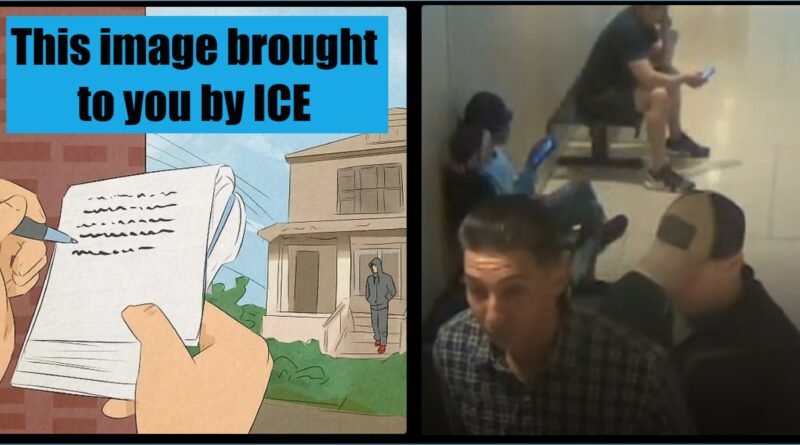Are Columbus police truly standing down?

ICE’s television ad enticing Central Ohio law enforcement with a $50,000 sign-on bonus claims officers in sanctuary cities have been “forced to stand down.” Columbus, as most everyone knows, is a sanctuary city even if no formal declaration was ever made. But Columbus, that has the most immigrants per capita in Ohio, is in a red state. And you don’t have to be Cesar Chavez to realize what side most of the Columbus police are on.
Back in 2017, Mayor Ginther ordered Columbus police to never ask a person’s immigration status or apprehend people if suspected of being an immigrant unless ordered by a court. But a question lingers in the minds of activists: Have some Columbus police and Franklin County deputies been surreptitiously helping Immigration and Customs Enforcement (ICE) by calling its snitch line and thus breaking city law?
The Columbus Division of Police has historically been one of the least transparent law enforcement departments in American history. It also has shot people of color at a disturbingly high rate. And according to a recent Dayton Daily News story, Franklin County leads Ohio this year in the number of immigrants it has jailed, that being 265. Meaning ICE has 48 hours to take them, and many from Franklin County are sent to the notorious Butler County jail north of Cincinnati. The jail has a contract with ICE and is run by Sheriff Richard Jones. An ultra-conservative anti-immigration blowhard referred to as Ohio’s “mini-Trump.”
Some of the 265 have a criminal record, but Ohio Immigrant Alliance director Lynn Tramonte believes most were detained after being pulled over for a traffic violation. Indeed, the Cincinnati Enquirer in July found that 7 out of 10 immigrants imprisoned at Butler County jail have no criminal record outside of violating immigration law, which is a civil violation. And of those with a criminal record, stated the Enquirer, most were for nonviolent crimes, like traffic offenses and DUIs (Driving Under the Influence).
Here’s a reminder of what Trump promised to do: rescue Ohio cities from immigrants who are “blood thirsty criminals.” Trump’s 2025 budget bill gave ICE billions in more funding to hire thousands more agents.
“All the police are hopped up and hyped up. Everybody is on edge. The country is on edge,” Tramonte said.
Telling is what Tramonte predicted soon after Trump won: “You’re going to have police vigilantism and local vigilantism. The reason Ohio is going to be bad from the beginning is that there’s so much eagerness from the general public who think, suddenly, they can do whatever they want, and call ICE on their neighbor.”
What she said then has come to fruition. In 2024, two off-duty white law enforcement officers approached a Black man they suspected of being an undocumented immigrant and a terrorist. How do we know they were profiling? The two officers admitted to this.
They asked the Black man what his nationality was. From Eritrea, he told them, but an American citizen, which he was. It didn’t matter. He was taken to the ground and placed in a leg lock by one of the officers.
Justice prevailed, however, as Cleveland police officer Donald Kopchak and Lake County Narcotics Agent Daniel Lajack were finally indicted in late August on charges of abduction and ethnic intimidation, which are felonies. Mindboggling yet predictable is how both said they believed the man was on the verge of committing an act of terror.
A sign of the times is what happened to Lake County Narcotics Agent Daniel Lajack after he committed this hate crime and came under investigation. Lajack resigned and took a job with the Portage County Sheriff’s Office, which is also a rural Ohio county with a contract with ICE. Meaning they too are eagerly working with ICE to fill its county jail with immigrants for which the federal government is paying handsomely.
The rural vs. urban tug-of-war now defines Ohio, but this partisan struggle has also creeped into the Franklin County court system. The Franklin County Municipal Court, responsible for misdemeanors and traffic violations, is allowing ICE agents to make arrests of immigrants who show up to pay speeding tickets. On the flipside, Franklin County Court of Common Pleas, which litigates felonies, has denied ICE – a court which mostly consists of Democrat judges.
Pictured above on the right is an arrest ICE made at the Municipal Court in June. That’s Leonardo Fausto, a Brazilian asylum seeker. Logic asks, why not pay the ticket online? What probably happened is that Fausto, lacking funds, went in front of a judge requesting to pay the ticket at a much later date.
Seeing ICE agents arresting immigrants paying speeding tickets, the Franklin County Public Defender Collective, a union, bravely spoke out against this. But the collective refused to answer Free Press questions about this due to the current climate of revenge. Which is another sign of the times – it’s becoming too dangerous to speak out.
No doubt immigrants who are being profiled by police like never before are avoiding the courthouse. What Tramonte wants to know is how exactly did ICE find out Fausto and others would show up to pay their traffic tickets? According to VisaVerge.com, “59 percent of ICE arrests in Republican-leaning states this year happened inside jails and prisons, thanks to strong cooperation with local police.”
“How did ICE even know about these cases?” she asks. “I can understand ICE might be going through the criminal dockets. But would they really be going through these dockets of accidents? Sounds kind of strange to me.”
The Free Press this past week sent a reporter to see whether ICE agents were still lurking in the hallways of the Municipal Court building downtown. We didn’t see any. We also spoke to a courthouse employee on the floor where traffic tickets are paid, asking if they had witnessed ICE agents making arrests of late. They said “no.” Not since the arrests which were made mid-summer.
“Honestly though, we truly don’t know if they are here. Because they are dressed in plain clothes,” said the employee who refused to offer their name for publication.
Source – Indonesia News




